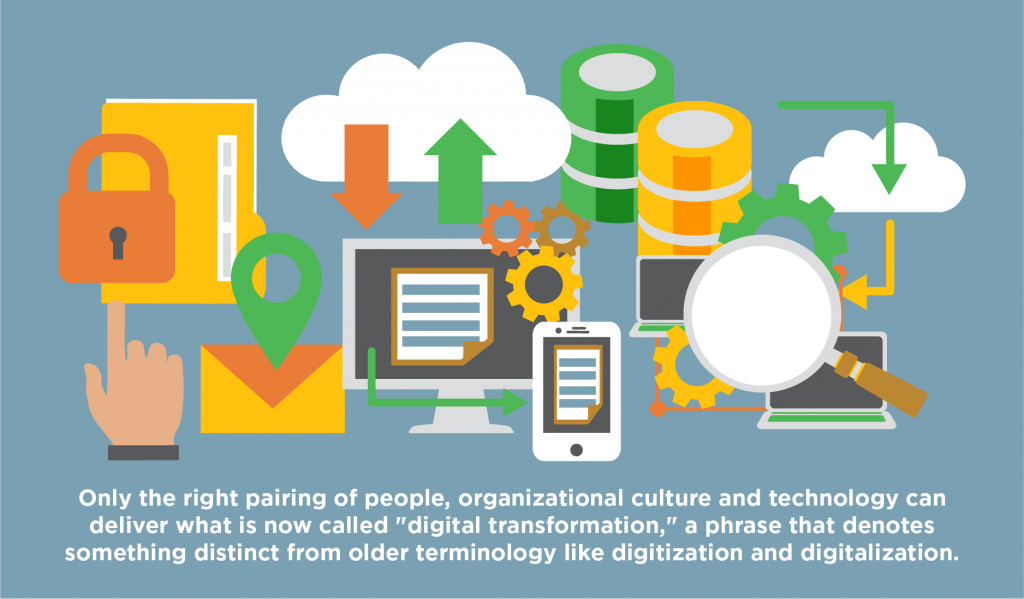When did digital technology become so pivotal to how organizations and individuals interact with each other? We could trace the history of digital dominance all the way back to the first mass-market home computers like the Apple II in the 1970s, an era that also Oracle and Microsoft being founded. The 1990 creation of the World Wide Web would be another good starting point. Or we could zero-in on the launch of the smartphone era in 2007 with the iPhone.
While the origins of digital transformation are debatable, one thing is for sure – whenever digital technology touches society, lives improve. But digital technology by itself does not spark profound change — for that, we need actual people who can find use cases for this tech within their workflows. Only the right pairing of people, organizational culture and technology can deliver what is now called “digital transformation,” a phrase that denotes something distinct from older terminology like “digitization” and “digitalization.” Let’s look at each one to see how they differ and how mature technologies like Oracle Cloud can accelerate digital transformation.

Digitization
This word typically refers to an analog-to-digital transition. A simple example is audio stored on a vinyl record — physical representations of its waveforms, etched within the record’s grooves — being sampled and converted into discrete digital values (ones and zeroes) for streaming or downloading. Digital photography also fits into this category, since the light entering the camera’s sensor is transformed and then recorded into a digital file format.
Digitalization
Whereas digitization is mostly about items – documents, songs, photos, etc. – digitalization is more about processes. Digitalizing a process means using digital technology to automate or otherwise change how it works. For example, pizza delivery has been digitalized over the decades, going from a process that was once primarily about making a phone call, to one that instead has numerous digital components behind the scenes. Dominos, for example, has re-conceived of itself as an “e-commerce company that sells pizza.” Two-thirds of its orders came in digitally as of 2019, thanks to GPS tracking, automated voice recognition ordering and other digitalized innovations.
Digital transformation
This is the most substantial of the three concepts discussed here. Digital transformation entails the replacement of manual and analog workflows with automated and digital alternatives, in a way that empowers employees and unlocks new business models and opportunities. In other words, digital transformation leads to fundamental change.
Some examples of digital transformation include:
- Implementing artificial intelligence-powered chatbots to revolutionize an organization’s customer service operations.
- Shifting a company’s critical systems of record, such its ERP or SCM platforms, from an on-premises setup into the cloud.
- Using marketing automation and more tightly integrated data to make sales operations more scalable and efficient.
- Offering digital services, like video streaming or on-demand ride hailing, that weren’t previously feasible.
The role of Oracle Cloud
Oracle Cloud offers multiple pathways toward digital transformation, for organizations across numerous industries. Disparate and aging systems can be replaced with more interconnected Oracle solutions, which can in turn be enhanced with IP Platform-as-a-Service (PaaS) offerings that bridge key gaps and simplify digital transformation without requiring extensive customization.
The combination of Oracle Cloud technology and Inspirage IP PaaS solutions helped a car retailer digitally transform its operations. This company was on the cutting edge of its industry, in terms of selling cars directly to consumers online instead of in-person at dealerships, and needed modern technological infrastructure to support its business ambitions. In this case, mere digitization or digitalization wouldn’t meet the retailer’s goals:
- Digitization would mean simply converting handwritten/paper documents into digital formats.
- Digitalization would entail moving the basic sales process online, something that had already happened.

In contrast, digital transformation would mean modernizing its systems from the ground up to support scalable operations. The company decided to pursue such an upgrade via the Oracle Cloud, with Inspirage’s expert help as well as its Spares and Reverse Logistics PaaS offering.
The end result was a new inventory system that supported the retailer’s increasingly complex operations. The state of the art inventory management system delivers end-to-end operational visibility including tracking for material transactions, cost of repair estimation, parts receipt and consumption tracking along with management of supplier payables. This digital transformation effort enables their vision of leading the $700B+ US used-car industry and supports breakneck expansion strategy.
Read the full customer spotlight for more information on how Oracle Cloud and Inspirage IP SaaS solutions transformed this customer’s business. You can also connect with Inspirage directly to get started on your own digital transformation project.